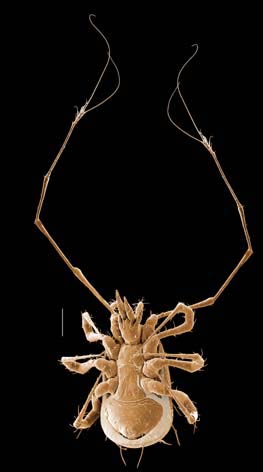Attenuate legs I
Sternal shield bearing 3 pairs of setae
Phytoseiid-type of sperm induction system
Tibia I and genu I each with 4/3 dorsal/ ventral setae; genu IV with
4/1-2 dorsal/ ventral setae.
Home | Mesostigmata (Monogynaspida) Home | Glossary
Podocinidae
Taxonomic Position
Cohort Gamasina
Subcorhort Dermanyssiae
Superfamily Phytoseioidea
Podocinum Berlese, Podocinella Evans & Hyatt
Diagnostic characters:
Attenuate legs I
Sternal shield bearing 3 pairs of setae
Phytoseiid-type of sperm induction system
Tibia I and genu I each with 4/3 dorsal/ ventral setae; genu IV with
4/1-2 dorsal/ ventral setae.
Similar taxa. Mesostigmatans with oval bodies covered by a single dorsal shield with tuberculate ornamentation and very long legs I that lack ambulacra are likely to be Podocinidae or Epicriidae. Epicriids have a small anal or ventrianal shield and several of the long setae on tarsus I end in small knobs. Species of Epicriopsis (Ameroseiidae) also have anal or small ventrianal shields and have claws and empodium on legs I. Species of Euepicrius (Ologamasidae) and Antennoseius (Ascidae) somewhat resemble podocinids, but have 2 subequal dorsal shields.
Diagnosis. Yellow to orange-brown hypotrichous dermanyssine mesostigmatans with holodorsal shield with 16-17 pairs of setae, a cerotegument in the form of a polygonal arrays of small tubercles, and with a pair of large gland openings posteriorly. Peritremes typical running to or past coxa I; peritrematal shield usually narrow, joining podonotal shield anteriorly. Sternal shield bearing 3 pairs of setae (st1-3) and 2 pairs of lyrifissures (stp1-2); metasternal shields subtriangular and bearing st4, stp3; genital shield usually trapezoidal and bearing 1 pair of setae; ventrianal shield broad, free, and bearing several pairs of ventral setae and 3 circumanal setae. Tarsus I slender, elongate, without claws, but with 1 (Podocinella) or 2 (Podocinum) whip-like setae; trochanter I with 6 setae; tibia I and genu I each with 4/3 dorsal/ ventral setae; genu IV with 4/1-2 dorsal/ ventral setae. Chelicerae chelate-dentate; movable digit without excrescences. Palp genu with 6 setae, palp apotele 3 tined; corniculi horn-like. Tritosternum biflagellate with columnar base. Tectum with 3 subequal tines each usually divided or toothed distally; subcapitular gutter with numerous denticles per row. Female sperm induction pores near base of coxae IV. Males with genital opening at base of tritosternum in sternogenital shield; spermatodactyl simple.
References
Evans, G. O. and Hyatt, K. H. 1958. The genera Podocinum Berl. and Podocinella gen. nov. (Acarina : Mesostigmata). Annals and Magazine of Natural History (12th series) 10 : 913-932.
Halliday RB. 1990. The occurrence in Australia of Podocinidae (Acarina: Mesostigmata), with description of two new species. Journal of the Australian Entomological Society 29: 277-280.
Lindquist EE, Wu KW. 1987. First record of the mite family Podocinidae (Acari: Mesostigmata) in Canada, with notes on other records in North America. Canadian Entomologist 119: 779-781.
Wong CL. 1967. A study of the biology of two species of Podocinidae (Acarina: Mesostigmata). Kansas University Science Bulletin 47: 575-600.